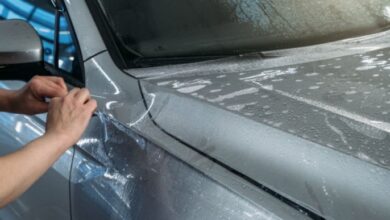Stay Safe and Focused on the Track
In the high-speed world of motorsports, safety is paramount. Racing suit safety standards are crucial in protecting drivers from potential hazards on the track, including fires, impacts, and extreme temperatures. With the right protective gear, racers can focus on their performance and confidently push their vehicles’ limits.
At FervoGear we believe that organizations like the SFI Foundation (SFI) have established rigorous certification processes to ensure that racing suits are up to the task. SFI, a non-profit organization dedicated to motorsports safety, has developed various performance specifications for racing equipment, including racing suits. One of the most recognized materials used in the construction of racing suits is Nomex, a flame-resistant fabric that offers exceptional protection without sacrificing comfort or mobility.
This guide will explore racing suit safety standards, focusing on the 3.2A/5 SFI Nomex racing suit certification. By understanding the importance of these standards and the unique properties of Nomex, racers and enthusiasts alike can make informed decisions about their protective gear and enjoy a safer, more thrilling experience on the track.
The SFI Foundation (SFI)
The SFI Foundation (SFI) is a key player in the motorsports safety landscape. Established in 1978, the non-profit organization was created to address the growing need for standardized safety measures and equipment in the racing industry. SFI’s primary purpose is to develop, administer, and promote safety specifications for various components and systems used in motorsports, ensuring that drivers, teams, and spectators are well-protected from potential hazards.
Origin and purpose
SFI plays a pivotal role in setting safety standards for motorsports by working closely with manufacturers, race-sanctioning bodies, and industry experts. Through this collaborative approach, SFI can develop comprehensive specifications that address the unique challenges racers face in different disciplines. These specifications are designed to promote safety while being practical and economically viable for manufacturers and teams.
Role in setting safety standards for motorsports
The SFI certification process is a rigorous and thorough system that ensures all certified products meet or exceed the safety specifications established by the organization. Manufacturers who wish to have their products certified must submit samples to SFI for evaluation and testing.
Once the product meets the required safety standards, the manufacturer is granted a license to use the SFI logo and certification number on their products, signifying their adherence to the established criteria.
SFI Certification Process
In addition to the initial certification process, SFI conducts regular audits of certified manufacturers to ensure ongoing compliance with safety specifications. This helps maintain the integrity of the SFI certification program and gives racers the confidence that their safety equipment is up to the task when they need it most.
Nomex Racing Suits
Nomex racing suits are an essential piece of safety equipment for drivers participating in various motorsports disciplines. These suits are designed to provide an unparalleled combination of protection, comfort, and durability, making them a popular choice among professional and amateur racers alike.
In 2021, the global motorsports market was valued at approximately $9.5 billion. Based on market projections, the market will grow at a compound annual growth rate (CAGR) of 6.7% from 2022 to 2027, reaching $13.7 billion by 2027.
Introduction to Nomex Material
Nomex is a flame-resistant material developed by DuPont in the early 1960s. It is a synthetic fiber belonging to the aramid family, which also includes materials such as Kevlar. The unique structure of Nomex fibers gives them inherent flame resistance, meaning they will not burn, melt, or drip when exposed to high temperatures. This makes Nomex an ideal material for protective clothing in industries where fire hazards are prevalent, including motorsports.
Properties and Benefits
The key properties of Nomex make it highly suitable for use in racing suits. Some of these properties include:
- Flame resistance: Nomex is inherently flame-resistant and does not lose its protective qualities with wear or washing. This ensures a consistent level of protection for the driver in the event of a fire.
- Lightweight: Nomex fibers are lightweight, allowing for the construction of racing suits that provide excellent protection without hindering the driver’s mobility or comfort.
- Breathability: Nomex is a breathable material, which helps regulate body temperature and wick away moisture, keeping the driver cool and comfortable during a race.
- Durability: The strength and resilience of Nomex fibers make them highly resistant to wear and tear, ensuring that racing suits have a long lifespan even under demanding conditions.
The Role of Nomex in Racing Suits
Nomex is the primary material used in many high-quality racing suits due to its unmatched combination of flame resistance, comfort, and durability. By incorporating Nomex into the design, manufacturers can create racing suits that provide exceptional protection in the event of a fire while still offering the flexibility and breathability needed for optimal driver performance.
Understanding the 3.2A/5 SFI Rating
The 3.2A/5 SFI rating is a specific classification within the SFI Foundation’s safety specifications for racing suits. This rating system is designed to quantify the protection a suit provides against heat and fire, ensuring that drivers are adequately shielded in an on-track fire-related incident.
Explanation of the Rating System
The SFI 3.2A rating system measures a racing suit’s Thermal Protective Performance (TPP), which indicates the suit’s ability to protect the wearer from second-degree burns in a fire. The numerical value following the 3.2A classification (in this case, “5”) signifies the specific level of protection the suit offers. The higher the TPP value, the longer a driver can be exposed to direct flame before sustaining burns.
Factors determining the 3.2A/5 Rating
Several factors contribute to a racing suit’s 3.2A/5 rating. These include the type of material used, the number of layers, and the suit’s overall construction. For a suit to be classified as 3.2A/5, it must meet specific TPP requirements set forth by SFI, which typically involve achieving a TPP value of 19 or higher. This means a driver wearing a 3.2A/5-rated suit should be protected from second-degree burns for approximately 10 seconds when exposed to direct flame.
Comparison to other SFI ratings
SFI racing suit ratings range from 3.2A/1 to 3.2A/20, with higher numbers representing increased levels of thermal protection. Choosing the appropriate rating depends on the type of racing and the specific fire risks associated with each discipline.
Key Features of 3.2A/5 SFI Nomex Racing Suits
3.2A/5 SFI Nomex racing suits boast several key features designed to optimize safety and performance for racers. These suits combine advanced materials, fire resistance, and a focus on fit and comfort to ensure drivers are well-protected and comfortable while competing on the track.
Layers and Materials:
A 3.2A/5 SFI-certified Nomex racing suit typically consists of multiple layers of material, which provide enhanced protection from heat and flames. The outer layer is made of Nomex, a high-performance, flame-resistant fabric that maintains its integrity even when exposed to extreme heat.
Fire Resistance:
One of the most critical features of a 3.2A/5 SFI Nomex racing suit is its fire resistance. Nomex is an inherently flame-resistant material that does not melt, drip, or support combustion when exposed to flames.
The 3.2A/5 rating signifies that the suit provides a minimum of 19 seconds of thermal protection before the wearer incurs a second-degree burn. This level of fire resistance is crucial in motorsports, where fires can occur due to fuel spills, engine failures, or accidents.
Fit and Comfort:
While safety is the top priority, a well-fitting and comfortable racing suit can also contribute to a racer’s performance on the track. 3.2A/5 SFI Nomex racing suits are designed with ergonomics and mobility in mind, allowing racers to move freely without feeling constricted.
Maintenance and Care of Nomex Racing Suits
Proper care and maintenance of your Nomex racing suit are essential to ensure its effectiveness and longevity. By following appropriate cleaning techniques, inspecting for wear and damage, and understanding the lifespan of your suit, you can keep your protective gear in optimal condition and maintain the highest level of safety on the track.
Proper Cleaning Techniques
It is crucial to follow proper cleaning procedures to preserve the flame-resistant properties and overall integrity of your Nomex racing suit. Consider these guidelines:
- Consult the manufacturer’s care instructions, as specific cleaning requirements may vary among brands and models.
- Machine-wash the suit separately in cold water using mild detergent. Do not use bleach, fabric softeners, or any other harsh chemicals, as they can degrade the suit’s protective qualities.
- Turn the suit inside out before washing to protect the outer layer from abrasion and reduce color fading.
- Use a gentle cycle and avoid high-speed spins, which can cause damage to the suit’s fibers.
- Air-dry the suit away from direct sunlight, as excessive heat or UV exposure can weaken the Nomex fibers.
- Do not dry clean or iron the suit; these processes can also damage the material.
Inspection for Wear and Damage
Regularly inspecting your Nomex racing suit for signs of wear and damage is crucial in ensuring it continues to provide the necessary protection. Look for the following indicators:
- Thinning or fraying fabric may compromise the suit’s flame resistance.
- Tears, holes, or cuts that expose the underlying layers of the wearer’s skin.
- Damaged zippers, fasteners, or seams could affect the suit’s integrity.
- Discoloration, fading, or signs of heat exposure may indicate reduced protective capabilities.
Suit Lifespan and Replacement
The lifespan of a Nomex racing suit depends on various factors, including the frequency of use, the intensity of racing conditions, and how well the suit is maintained. Generally, manufacturers recommend replacing racing suits every 3-5 years or after a significant crash or fire incident. Always adhere to the manufacturer’s guidelines and consult your racing organization for specific replacement requirements.
Wrapping Up
Understanding the 3.2A/5 SFI Nomex racing suit certification is essential for racers and enthusiasts seeking the highest level of safety on the track. This guide has explored the importance of racing suit safety standards, the unique properties of Nomex, and the stringent certification process by the SFI Foundation. These factors ensure that racers have reliable safety equipment that can meet the intense demands of motorsports.
Nomex racing suits offer advanced materials, fire resistance, and comfort to keep drivers protected and focused on their performance. By selecting a suit with the appropriate SFI rating and diligently maintaining its condition, racers can confidently invest in their safety and enjoy a thrilling experience on the track.




